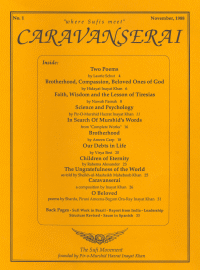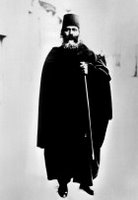
Caravans are of interest not only to merchants and mystics, but also to scholars. In trying to trace the history of the human family, historians, archaeologists, paleo-anthro-pologists and other learned specialists often rely on the evidence of ancient trade routes. By studying the spread of a certain kind of pottery along these old pathways, for example, they hope to be able to say that some civilization grew out of some other, or show that this group learned writing from that, and then passed it on to others.
Usually the archae-and-other-ologists must study the hardware of a culture — the spear points, the pots, the fragments of corroded bronze. Rarely, we may get a look at the more transient artifacts of pre-literate societies, such as leather, cloth or basketry. Very seldom indeed, though, do we catch even a glimpse of what could be called the software of an old culture. In other words, we may conclude that a certain tribe valued cedar or traded bone buttons for ochre, but we have difficulty knowing just how the people of that tribe adorned themselves, or why they did it that way.
We can be certain, though, that customs and beliefs were passed along the trade routes, just as rope and salt and grain were. Over many years, the rhythm of whole trading caravans shuttling between different groups of people would have a profound effect.
Was there, then, some ancient ur-belief from which all later faiths have sprung? No. It was styles of belief that were exchanged, not the root of belief. The root of belief is universal. If it were not, there would be some people who believed, and others who had no belief. We can see, though, that every culture has a belief, and so does every individual. Even in this age, when faith is regarded by many as an optional lifestyle accessory, yet each one has a belief in something. Instead of looking for the grandfather of all religions, the student of unity should turn instead to the origin of religions, which is in the tendency to faith and aspiration found in the heart of every human.
Solomon the Wise said, "There is nothing new under the sun." It is a phrase often quoted when scientists, after great labour and expense, manage to reproduce artificially something a mosquito, perhaps, does quite naturally, and without spending a penny. But Solomon was not speaking of technology. He was speaking of that for which his name is now synonymous — wisdom. Wisdom has not changed since the dawn of the whole creation.
But surely Solomon had not heard the sutras of Gautama Buddha. Nor could he have known the Sermon on the Mount, nor the Holy Quran. How, then, could he proclaim wisdom complete, before Buddha, Jesus, Mohammed and other great teachers even got on stage?
It is like asking if the rain was different in the time of Solomon, or if the ancients had a different source of light from the sun, or if they breathed a different air. Real wisdom comes from a tuning of the heart and mind and spirit to the infinite wisdom of the seen and unseen universe, which some respectfully call God, others Allah, and still others humbly abstain from trying to name at all. It is the only source of the wisdom which graced Solomon's life, and it must be the same which inspired Rama, Shiva, Buddha, Zarathustra, Jesus, Mohammed, and all the wise souls, known and unknown to the world.
But if the same wisdom inspired each of these Messengers, why has the Message been sent again and again? Wouldn't once be enough? In fact, don't these different Messengers cause a lot of confusion by saying apparently different things? One could imagine the generality asking the Messengers to please get together, come up with one version, and stick to it.
But once is enough, for those who are awake to hear the wisdom pouring forth from these divinely inspired teachers. For those who are ready, a single word kindles an unquenchable flame in the heart. Many of us, however, are still sitting groggily on the edge of the bed — or are even still sound asleep in dream land. And in this material world, even the pure notes of the most finely tuned bell must fall beneath the hubbub of the crowd eventually. If the tones of wisdom, which guide and inspire all those seeking an answer to the mysteries of life, are to remain audible, the bells must ring again and again.
It is also true that the awakened ones have had to work with the (temporary) limitations of those they sought to raise up, and for that reason, they have cast the Message in different forms. It is only the need of the children that has caused so much diversity in the Message. The need is not in the Messengers.
The truly awakened souls hear wisdom speaking in the fall of a leaf, or the unfolding of a bird's wing, or in the silent singing and dancing of the stars. It is the students and the students of the students who have needed more tangible forms of teaching, accommodating their limitations. Therefore, at different times and places, the Message has been given in various forms — but those who study the inner meaning of these teachings will find no contradiction among them. It would be like looking into « different pools of water, and saying, 'In this one I see reflected a tree, and in that one, a mountain — therefore, one holds water, and the other does not.' The water reflects the place where it has fallen, but it is water all the same.
We know that the human race is one. Divisions rise up but they fall away, too. They are temporary, because they are based, after all, on illusion. From space, no borders are visible upon the globe. How, then, could wisdom be the possession of one particular group of people? It cannot. Wisdom is a light within all, waiting to be uncovered, and it matters nothing at all if the student digging to uncover that glow is guided by the whispers of the Master Jesus, or the strong hands of Moses, or the clear gaze of Lao Tzu. It only matters that he or she keep on digging.
But, some might say, in certain places they have a wisdom not known elsewhere. In the west there is material science, but in the east, there is mystical science — isn't there? If there is only material science in the west, how can there be wisdom?
The answer is that mystical science may be, or may once have been more readily accepted in the East, but wisdom is universal, accepted or not, and one proof of this is given in the story of Tiresias.
In ancient Greek legends, Tiresias was a blind sage. He appears in the plays of Sophocles, and in the story of Odysseus as well. When Odysseus was unable to get home after the Trojan wars, he at last sailed to the margin of the underworld, where he made a sacrifice in order to consult the shade of Tiresias. The existence of Tiresias is not that remarkable in itself, since every culture has sages. What is intriguing about Tiresias is the stories of how he came to be blind.
There are two versions to this story. One is that his mother, Chariclo, was a nymph, and a favourite companion of the Goddess Athena. Chariclo and Athena enjoyed bathing at a certain spring, and it happened one day that the youthful Tiresias, out hunting, caught sight of the naked Goddess. Aware of his glance, she instantly covered his eyes with her hand. Her touch struck him blind, but from sympathy for his mother, she gave Tiresias some compensation. His ears were opened, that he might understand the speech of birds; he received a staff able to guide him as well as if he could see; he was given the gift of prophecy and a life seven times as long as an ordinary mortal. One might wonder, if the goddess could do all this, why she did not merely restore his sight, but the story is symbolical, as we shall see in a moment.
The second version of how Tiresias was blinded is more elaborate. It is told that one day, walking on a mountainside, Tiresias saw two snakes coupling. Tiresias, not a member of the ecologically-minded Green Party, struck at the snakes with his staff, happened to strike the female, and was himself turned to a woman on the spot. He (or she) remained female for seven years, until he (or she) happened to again encounter a pair of coupling snakes, struck this time the male, and was restored to his (or her) former state.
Some time later, Zeus and Hera, the divine archetype of the quarreling married couple, were arguing about whether it was the man or woman who gets greater pleasure from sexual intercourse.* They decided to consult Tiresias, inasmuch as he had been both, and presumably would know the answer. Hera had declared that men got more pleasure from sex than women, but when Tiresias stated that women got nine times the pleasure, she was enraged and vengefully struck him blind. This time, it was Zeus who gave Tiresias the compensation of prophecy, being unable to undo his wife's act.
There is ample room in these stories for speculation on such themes as the battle of the sexes, man against nature and the psychology of the ancient Greeks, but these are only the cultural cloak for a profound, mystical symbolism. It is easily grasped in the first version: Tiresias, glimpsing the divine presence unveiled, indeed being touched by the divine presence, becomes blind to the outer world. One who has seen the beauty of the inner world cares no more for the illusion of the outer — but he is more sensitive, not less, and Tiresias' gifts testify to this.
Curiously, the second version tells the same story, though in a slightly different fashion. To anyone interested in such matters, the image of a male and female snake entwined immediately suggests the channels of energy spiraling up the spine, known to yogis and Sufis as Ida and Pingala, or the lunar and solar, or the receptive and expressive forces. Striking the female, Tiresias became that, or in other words, put his breath in that channel. Subsequently striking the male, he opened that channel, and then had both channels open. When both channels of the breath are open and unite in the seat of wisdom, known as the third eye, the mystic is in ecstasy; the seeker forgets himself in God-consciousness. In other words, the tale of the snakes is another way of saying that Tiresias stood before the Divine Presence, and the result was the same — blindness to the outer world, and an awareness of the inner which poured forth as prophecy.
The story of Tiresias is not only a wonderful distillation of truth, but it also shows us that wisdom is known in every culture, hidden in symbols appropriate to the time and place.
Wisdom is neither eastern nor western. It is not exclusive to churches, mosques, nor even Sufi temples, though it is the source of every faith and aspiration. It is everywhere, hidden in every form and every being, waiting patiently to be discovered. But those who have been true to their own aspiration, and looked into the depths of their own hearts first will have more success in seeing the light of wisdom elsewhere.
* I leave it to the reader to surmise how this argument started
Labels: 1988 volume 1











